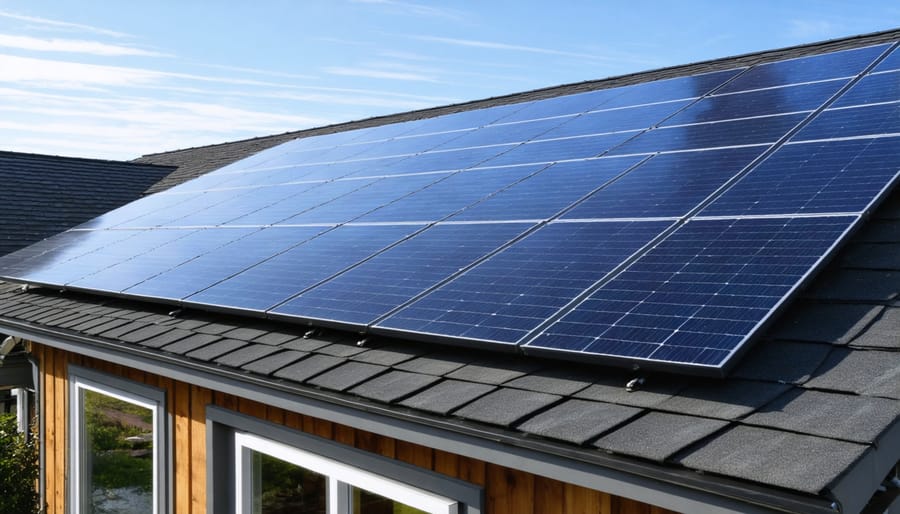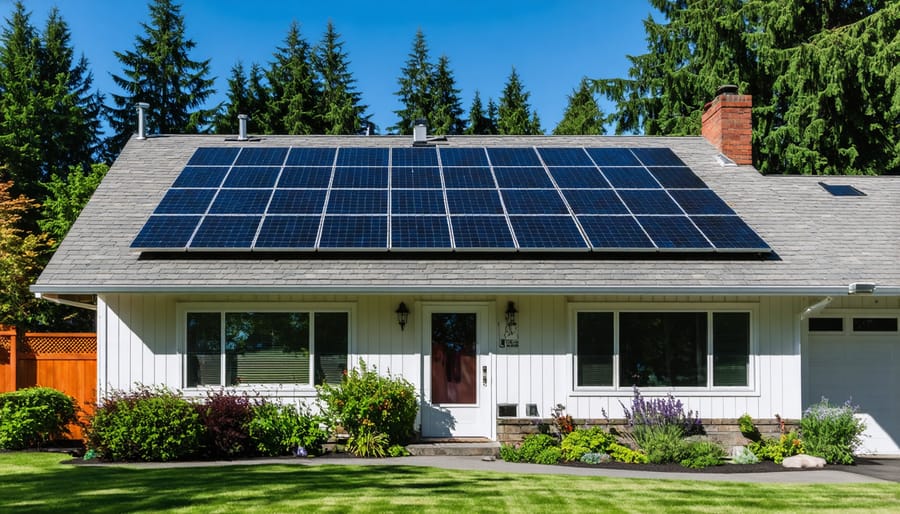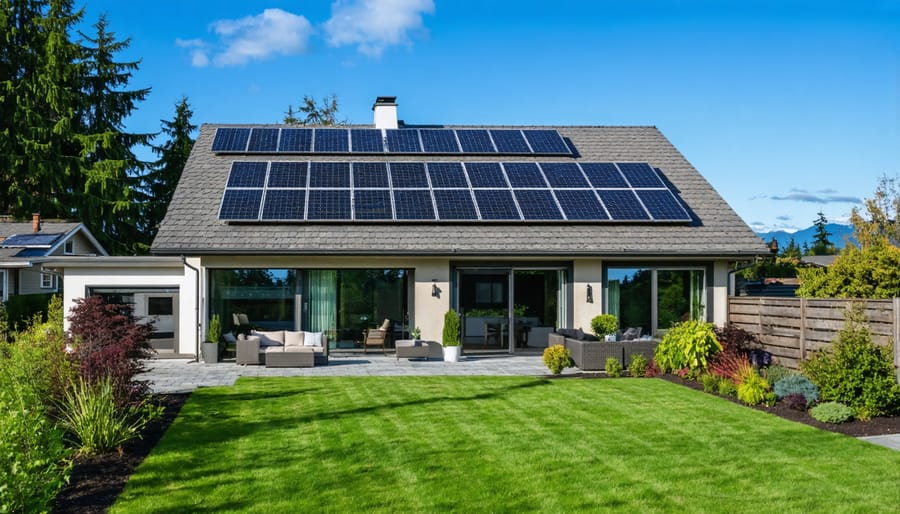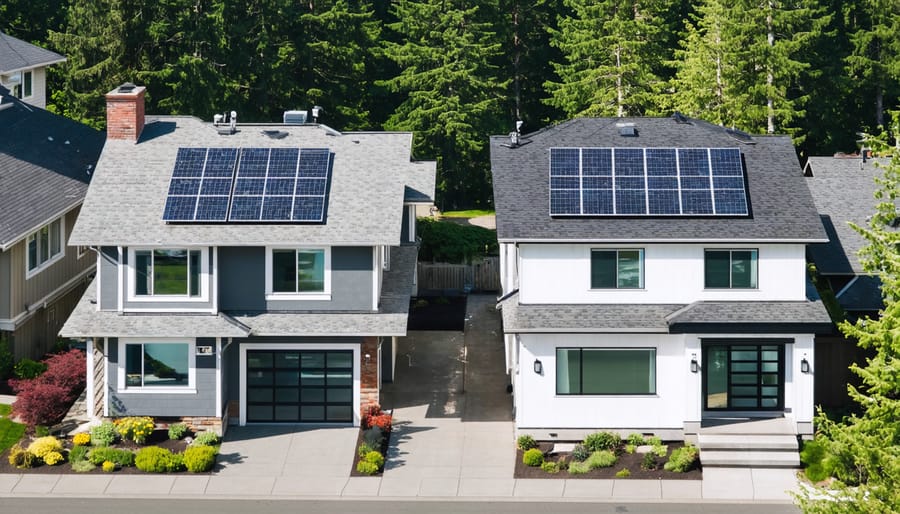Compare Washington State’s solar incentives against British Columbia’s programs to understand your true return on investment. Washington offers a sales tax exemption on solar equipment, federal Investment Tax Credit access, and net metering policies that credit excess energy production at retail rates. Meanwhile, BC residents benefit from PST exemptions on qualifying solar systems, CleanBC rebates for solar-plus-battery installations, and net metering agreements through BC Hydro that can eliminate electricity bills entirely.
Calculate your potential savings by examining both jurisdictions’ actual installation costs and payback periods. Washington homeowners typically see 8-12 year payback periods due to higher electricity rates averaging 10.5 cents per kWh, while BC’s lower residential rates of 12-14 cents per kWh for higher-tier consumption still create compelling returns, especially when paired with battery storage incentives. The key difference lies in long-term electricity price trajectories—BC Hydro rates have increased steadily, making solar a hedge against future costs.
Request quotes from local BC installers who understand regional incentive stacking opportunities. Many BC homeowners overlook combining provincial PST exemptions with municipal property tax exemptions and utility-specific programs. Richmond, Surrey, and Vancouver have implemented additional rebates and expedited permitting processes that significantly improve project economics.
Evaluate cross-border lessons applicable to your situation. Washington’s success with community solar projects and solar-ready building codes offers a blueprint for BC advocates pushing for enhanced provincial support. Understanding what works south of the border strengthens your case for solar adoption regardless of current incentive gaps.

Washington State’s Solar Incentive Landscape: What’s on Offer
Federal Investment Tax Credit (ITC) in Action
Washington homeowners benefit from the federal Investment Tax Credit (ITC), which covers 30% of total solar installation costs. This substantial incentive applies to equipment, labor, and even battery storage systems installed alongside solar panels.
Here’s how it works in practice: If a Washington homeowner installs a solar system costing $20,000, they can claim a $6,000 tax credit directly reducing their federal tax liability. For a larger $30,000 system, the credit reaches $9,000. Unlike deductions that simply reduce taxable income, this credit provides dollar-for-dollar savings on taxes owed.
The ITC applies as a credit against your federal income taxes, so you’ll need sufficient tax liability to claim the full amount in one year. However, any unused portion can roll forward to future tax years, ensuring you capture the complete benefit over time.
For BC residents comparing options, this 30% federal incentive represents a significant advantage for Washington installations. While BC offers its own provincial incentives and net metering programs, understanding Washington’s federal support helps contextualize the regional solar landscape and highlights how different policy approaches impact overall system affordability across the border.
Washington State-Specific Programs
Washington State offers several noteworthy incentives that BC residents might find interesting for comparison purposes. Understanding what’s available south of the border helps contextualize BC’s solar landscape and highlights opportunities for advocacy in your own community.
The state provides a sales tax exemption on solar equipment purchases, which can reduce upfront costs by approximately 8-9%. This exemption covers solar panels, inverters, and installation materials, making the initial investment more accessible for homeowners and businesses alike.
Washington’s net metering policy allows solar system owners to receive retail-rate credits for excess electricity sent back to the grid. When your panels produce more energy than you consume, your meter effectively runs backward, offsetting future electricity bills. This policy ensures you get full value for every kilowatt-hour your system generates. Many utilities in Washington maintain rolling credit balances that carry forward month-to-month, maximizing your return on investment.
While Washington’s former Renewable Energy System Cost Recovery Program expired in 2020, its legacy demonstrates how state-level incentives can accelerate solar adoption. During its operation, participants received production incentives of up to $5,000 annually, spurring significant residential and commercial installations.
For BC residents, these programs illustrate effective policy models that could inspire similar initiatives locally. While Washington’s incentives differ from BC’s offerings, both jurisdictions share a commitment to renewable energy. Understanding these differences empowers you to make informed decisions about solar investment at home and potentially advocate for enhanced provincial incentives.
Local Utility Rebates and Perks
Washington utilities sweeten the solar deal with their own rebate programs beyond state incentives. Seattle City Light offers net metering, allowing solar customers to receive retail-rate credits for excess electricity sent back to the grid—essentially banking power for cloudy days. Puget Sound Energy provides similar net metering benefits plus streamlined interconnection processes to make installation easier.
Some smaller municipal utilities, like Snohomish County PUD, offer additional incentives that can reduce upfront costs by several hundred dollars. While these programs vary by service area, they typically include expedited permit processing and technical support throughout your solar journey.
For BC residents weighing Washington’s offerings against home options, it’s worth noting that BC Hydro’s net metering program operates similarly. The key takeaway? Both regions support solar adoption through utility cooperation, though Washington’s competitive utility market sometimes creates more diverse program options. Contact your local Washington utility directly to explore current rebates—programs change frequently as solar adoption grows.
British Columbia’s Solar Incentive Reality Check
What BC Offers Today
While BC’s incentive landscape differs from Washington State, our province offers several valuable programs that make solar energy increasingly accessible and affordable for homeowners.
At the federal level, the Canada Greener Homes Grant provides up to $5,000 for eligible home energy retrofits, including solar installations. This grant requires a pre- and post-retrofit EnerGuide evaluation, but the process ensures your home receives a comprehensive energy assessment. Additionally, the Canada Greener Homes Loan program offers interest-free financing up to $40,000 with repayment terms of 10 years, making upfront costs more manageable for families considering solar.
BC’s net metering program remains a cornerstone benefit for solar adopters. Through this provincial initiative, homeowners can send excess electricity back to the grid and receive credits on future utility bills. While the compensation structure differs from Washington’s approach, net metering effectively reduces your annual electricity costs and maximizes your solar investment’s value.
Several BC municipalities have stepped up with local incentives. The City of Vancouver, for instance, offers expedited permitting for solar installations, reducing wait times and administrative costs. Other communities provide property tax exemptions for the added home value from solar systems, ensuring your investment doesn’t increase your tax burden.
Beyond formal programs, various BC solar rebates and utility-specific initiatives exist throughout the province. For example, some regional districts offer grants for renewable energy projects in rural areas, while certain utilities provide rebates for battery storage systems paired with solar panels.
The key takeaway? While our incentive structure operates differently from Washington State, BC residents have access to substantial financial support that makes solar energy a practical, economically sound choice for reducing both carbon footprints and electricity bills.
The Gap Between BC and Washington
At first glance, Washington State’s solar incentive landscape might seem more robust than BC’s, but the reality is more nuanced than you’d expect. Let’s break down where each jurisdiction truly stands.
Washington State has historically offered production incentives that paid homeowners for every kilowatt-hour their systems generated. While impressive on paper, many of these programs have expired or been significantly scaled back. Their state-level solar tax credit ended in 2020, leaving primarily federal incentives and net metering. Currently, Washington residents rely heavily on the federal Investment Tax Credit, which covers 30% of installation costs through 2032.
BC residents, meanwhile, benefit from CleanBC rebates that can reach up to $5,000 for residential installations, plus additional support for low-income households. When you factor in BC Hydro’s net metering program, which credits excess power at retail rates, the financial picture becomes competitive.
Here’s where it gets interesting: a typical 5-kilowatt residential system costs approximately $15,000 to $18,000 in BC after rebates, compared to $12,000 to $16,000 in Washington post-federal credit. The gap exists, but it’s narrower than many assume.
Where BC actually excels is in long-term energy cost stability. BC Hydro rates remain among North America’s lowest, meaning your solar savings compound differently. A Vancouver family installing solar in 2023 reported breaking even within 12 years, despite lower electricity rates making the payback period longer than Washington’s 8-10 years.
The Sunshine Coast Community Energy Cooperative demonstrates this advantage beautifully. Their members collectively generate clean power while maintaining predictable energy costs for decades, proving that BC’s incentive structure supports sustainable, community-driven solar adoption even if the upfront rebates seem smaller.


Real Payback: What These Incentives Mean for Your Wallet
A Tale of Two Installations
Let’s look at how solar pencils out on both sides of the border with a real-world comparison.
Meet the Johnsons in Seattle and the Millers in Vancouver. Both families installed similar 6 kW solar systems on their homes in 2024. Here’s how their experiences differ.
The Johnsons paid approximately $18,000 USD for their installation before incentives. They immediately benefited from the federal Investment Tax Credit, which covered 30% of their costs, reducing their out-of-pocket expense to $12,600. Washington State doesn’t currently offer additional state-level rebates, but they do benefit from net metering, allowing them to bank excess energy credits during sunny summer months. Their utility also provides a modest production incentive. With energy costs averaging $0.11 per kWh in Seattle, the Johnsons expect to recover their investment in roughly 10-12 years.
The Millers in Vancouver faced a different scenario. Their 6 kW system cost about $16,500 CAD upfront. While BC doesn’t offer the same federal tax credit as the US, they benefited from CleanBC incentives and financing options through programs like the Canada Greener Homes Grant, which provided up to $5,000 in rebates. BC Hydro’s net metering program works similarly to Washington’s, banking credits at retail rates. With BC’s higher electricity rates averaging $0.14 per kWh, the Millers’ solar payback periods actually compete favorably at 11-13 years, despite different incentive structures.
The takeaway? While Washington’s tax credit is substantial, BC’s combination of grants, competitive installation costs, and higher electricity rates creates comparable long-term value. Neither location has a decisive advantage, making solar a smart choice on both sides of the border.
BC’s Hidden Advantage: Lower Electricity Rates
BC residents enjoy some of North America’s lowest electricity rates, thanks to BC Hydro’s abundant hydroelectric resources. While this is excellent news for monthly bills, it does change the solar equation compared to Washington State.
In Washington, residential electricity rates average around 10-12 cents per kilowatt-hour, significantly higher than BC’s typical rate of 9-11 cents for Tier 1 usage. This difference means Washington homeowners see faster payback periods on their solar investments, as each kilowatt-hour of solar electricity replaces more expensive grid power.
However, BC’s tiered pricing structure creates an interesting opportunity. Once your BC household electricity usage exceeds the Tier 1 threshold (approximately 1,350 kWh per billing period for most residential customers), you’re paying nearly double at the Tier 2 rate. Solar installations can help you stay within the lower tier, maximizing savings.
Consider the Thompson family in Kelowna, who installed a 5kW system. While their per-kilowatt-hour savings were modest, avoiding Tier 2 charges during summer air conditioning season reduced their annual costs by 18 percent. The key is understanding your consumption patterns and sizing your system appropriately to capture the greatest value from BC’s rate structure.
What BC Residents Can Learn From Washington’s Approach
Policy Strategies Worth Adopting
Washington State’s incentive structure offers several proven approaches that BC policymakers could adapt to strengthen local solar adoption. Their sales tax exemption on solar equipment purchases significantly reduces upfront costs, making installations more accessible to middle-income households. This straightforward approach eliminates price barriers without complex application processes.
The state’s net metering policies provide another valuable model. Washington allows solar homeowners to bank excess energy credits year-round, ensuring fair compensation for power contributed back to the grid. BC currently has limited net metering capacity, and expanding this program would immediately improve return on investment for residents.
Washington’s focus on workforce development through solar training programs has created local jobs while reducing installation costs through increased competition. BC communities could benefit from similar initiatives, building homegrown expertise rather than relying solely on external contractors.
Additionally, Washington offers streamlined permitting processes that reduce administrative delays and soft costs. Combined with improved solar financing options, these policy elements would make BC’s solar landscape more competitive and attractive to both homeowners and businesses ready to transition to clean energy.
Advocacy Opportunities for BC
BC residents have a unique opportunity to advocate for solar incentives that match or exceed what Washington State offers. Start by connecting with your local MLA to express support for enhanced solar rebates and net metering improvements. Reference Washington’s successful programs as proven models that balance environmental goals with economic benefits.
Join community groups like the BC Sustainable Energy Association, which actively lobbies for better renewable energy policies. These organizations amplify individual voices and provide research-backed proposals to government officials. Consider sharing your solar journey or interest in adoption with local media to highlight grassroots demand for cleaner energy solutions.
Municipal governments often lead where provincial policies lag. Attend city council meetings to propose local solar initiatives, such as expedited permitting processes or property tax exemptions for solar installations. Several BC communities have already implemented innovative programs by learning from cross-border examples.
Engage with your utility provider through public consultations about rate structures and interconnection standards. Washington’s streamlined approach to grid connection demonstrates how utilities and solar customers can coexist beneficially. Your input helps shape policies that make solar more accessible and financially attractive for all British Columbians.
Making Solar Work in BC Right Now
Stacking Every Available Incentive
While Washington State residents enjoy a robust stack of solar incentives, BC homeowners can adopt similar strategies to maximize their own savings. Here’s how to layer available programs effectively.
Start with the federal foundation. Apply for the Canada Greener Homes Grant, which provides up to $5,000 for solar installations. Schedule your pre-retrofit EnerGuide evaluation first, as this assessment is required to access the grant. The evaluation costs around $300-400 but is partially reimbursed through the program.
Next, explore financing options. The Canada Greener Homes Loan offers interest-free financing up to $40,000 over ten years. This eliminates upfront cost barriers and pairs perfectly with the grant. Calculate whether your monthly loan payment will be offset by electricity savings—in most BC cases, the math works favorably.
Check your local utility programs. BC Hydro and FortisBC occasionally offer solar rebates or net metering programs that credit you for excess electricity sent back to the grid. Contact your utility provider directly to understand current offerings, as these programs evolve regularly.
Don’t overlook municipal incentives. Some BC cities provide property tax exemptions for solar equipment or expedited permitting processes. Victoria and Vancouver have pioneered such programs, making installation smoother and more affordable.
The Saanich family we profiled earlier stacked the federal grant with an interest-free loan and BC Hydro’s net metering program, reducing their effective system cost by 45%. By methodically combining available programs, BC residents can achieve competitive savings that rival Washington State’s incentive packages.

Local Success Story: Vancouver Island Installation
Meet Sarah Chen from Courtenay, who installed a 6.5 kW solar system on her Vancouver Island home in spring 2023. Her total project cost was $18,200 before incentives. Through the Canada Greener Homes Grant, Sarah received $5,000 back, reducing her net investment to $13,200.
Sarah also qualified for a 0% interest loan through the BC Hydro financing program, spreading payments over ten years at just $110 monthly. Her system now generates approximately 7,800 kWh annually, slashing her electricity bills by $780 per year thanks to BC Hydro’s net metering program.
“I was hesitant at first, especially after reading about Washington State’s incentives,” Sarah admits. “But when I crunched the numbers with a local installer, I realized BC’s programs work differently but still make solar worthwhile. My payback period is around 17 years, and with rising electricity rates, that timeline keeps improving.”
Sarah’s panels have performed exceptionally well through Vancouver Island’s sunny summers and mild winters. She now produces more energy than her household consumes from April through September, building credits that offset winter usage.
While Washington State’s solar incentives paint an impressive picture, don’t let the comparison discourage you from exploring solar in British Columbia. The reality is that solar remains a viable and increasingly worthwhile investment for BC homeowners, even with more modest provincial incentives.
Yes, Washington residents enjoy stronger financial incentives, but BC has its own advantages that shouldn’t be overlooked. Our net metering programs ensure you’re credited for excess energy production, hydro rates continue to rise (making solar savings more significant over time), and installation costs have dropped dramatically in recent years. Additionally, BC’s commitment to clean energy goals suggests future policy developments may further support residential solar adoption.
The key is understanding whether solar makes sense for your specific situation. Your home’s orientation, roof condition, energy consumption patterns, and local utility rates all play crucial roles in determining your return on investment. Many BC families are already experiencing significant savings and environmental benefits from their solar installations, proving that attractive incentives aren’t the only path to solar success.
Ready to explore your options? Start by using our interactive solar savings calculator to estimate your potential returns based on your unique circumstances. Then, connect with local solar installers who understand BC’s regulatory landscape and can provide customized assessments. Solar in BC isn’t just viable—for many homeowners, it’s a smart financial and environmental decision worth pursuing today.

